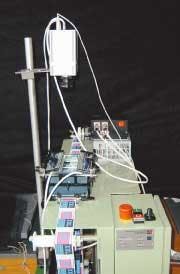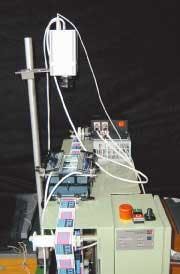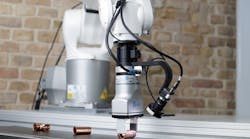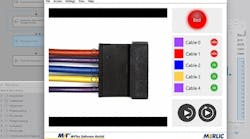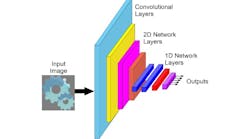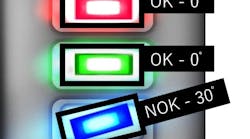Jakob Müller GmbH (Schwelm, Germany; www.mueller-frick.com) builds automated manufacturing equipment to produce narrow fabric items such as ribbons and labels. During manufacturing, labels up to 15 cm long × 8 cm wide are woven in long reels. These textile labels are cut and sewn onto suits and jackets.
Before this can be done, however, each label must be visually inspected for faults such as missing fibers and dirt spots. Jakob Müller contracted Analogic Computers (Budapest, Hungary; www.analogic-computers.com) to retrofit one of its label-cutting machines with a machine-vision system to identify these faults and trigger the system to reject faulty labels.
According to Robert Fekete, sales and marketing manager with Analogic, several obstacles needed to be overcome in the design of the system. “Labels running at up to 4 m/s may appear distorted as they are pulled through the machine,” he says “In addition, the fine texture of the woven label may appear as noise on images digitized by the camera.” To overcome these obstacles, the company used its Bi-I v.2 smart camera to digitize labels from the label-cutting machine.
With a 1280 × 1024-pixel, 2/3-in. CMOS sensor from Fillfactory (Mechelen, Belgium; www.fillfactory.com) and an on-board TMS320C6415 DSP processor from Texas Instruments (TI; Dallas, TX, USA; www.ti.com), the camera was mounted approximately 12 in. over the label reel (see photo). “This,” says Fekete, “provides an image resolution of about 0.3 mm/pixel, and thus a typical 5 × 10-cm label is represented as an image of 55,000 pixels.” Because the inspection rate required was 4 m/s, 40 images needed to be processed each second, requiring a per image processing time of 25 ms. “Since these labels are moving so rapidly,” says Fekete, “the image-integration time must be very short to avoid blurring.”
Because of this short shutter time, very intense lighting was required, a problem Analogic overcame by developing its own rapidly strobed LED lighting fixture placed above the camera system. To detect any missing fibers or dirt spots in each image, the vertical position of each label is calculated and portions of characteristic patters within the image identified.
Using these reference points, a bilinear interpolation algorithm running on the DSP is recorrects any distortion the label may have been subjected to by machine tension. The corrected image is then compared with a known good “golden template” reference image, which results in an error image. After this error image is binarized, each number of active pixels with a specified threshold level is counted. This results in a pass/fail value that is transmitted to a host programmable logic controller, which, in turn, triggers the cutting mechanism of the machine.
To develop the image-processing algorithms for this application, Analogic InstantVision software development library was used. Running under a Windows-based API, the library contains image-processing functions for running camera-based applications and controlling the data flow between the camera and host PC. Running in conjunction with TI’s Code Composer, the API contains an image processing library, camera-to-PC communications library, and the Ibis library for reading images from the camera’s sensor.
Using the library, image-processing functions developed on PC-based systems can be downloaded to the camera over a 100-Mbit Ethernet interface. “Because the camera features an Ethernet interface,” says Fekete, “classified dirt or fiber faults can be logged to a PC-based host computer and used in spreadsheet analysis data format to provide the operator with immediate feedback about the manufacturing process.”
